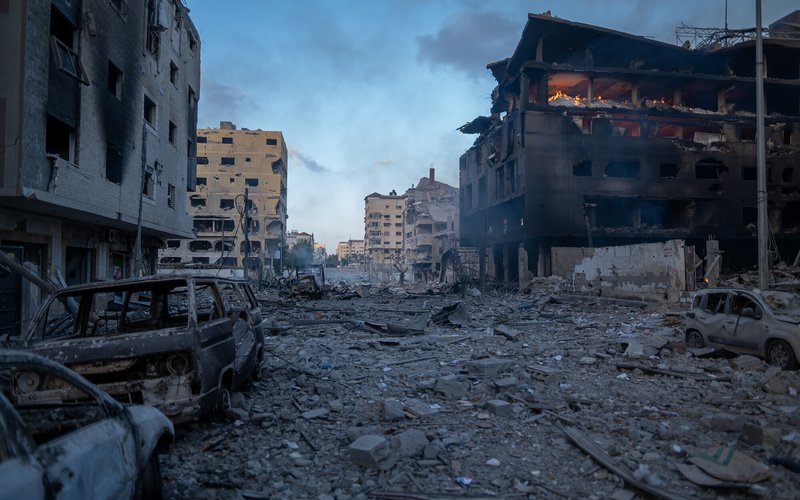Oxfam partners are trying to get food, clean water, and medicine to desperate families. Here’s the latest, and what you can do to help.
Getting humanitarian aid into Gaza is a complicated mess—but it shouldn’t be.
With a fragile ceasefire agreement now in peril, Oxfam and other aid groups are ready to scale up to deliver more food, clean water, and medicine to millions of Palestinians in need. Despite overwhelming needs, the Israeli government is still allowing just a small fraction of the humanitarian aid needed into Gaza.
“The ceasefire must immediately unlock full and unrestricted humanitarian access to Gaza, supported by the international community ensuring that a sustainable ceasefire is upheld,” said Abby Maxman, President and CEO of Oxfam America. “The international community must also ensure that Israel opens all crossings and allows aid and commercial goods to flow freely and safely at scale into every corner of the Strip.”
Oxfam is calling for unhindered access to vital aid in Gaza. We stand ready to scale up the delivery of humanitarian aid once access is granted.
Gaza’s urgent need for increased aid delivery
Palestinians in Gaza are in desperate need of humanitarian aid. The most pressing needs include food and healthcare, as well as water, sanitation and hygiene services (WASH) including menstrual products and waste management services.
- In August, famine was confirmed inside Gaza City and projected to expand into other areas. While limited food and other goods have become more available in some local markets, they remain largely unaffordable for many Palestinians.
- About 90 percent of water and sanitation sector assets have been damaged or destroyed, and 92 percent of housing units are damaged or destroyed.
- Twenty-one of the 50 nutrition centers in Gaza City have recently closed, cutting off care for around 4,000 children.
Children are particularly at risk. Nearly 71,000 cases of acute malnutrition among those aged 6 to 59 months have been projected to occur through March 2026, including 14,100 severe cases.
Other UN agencies also report that many women are struggling to produce milk and find food to feed their families while suffering from depression, anxiety, and nightmares.
What is the current situation on aid entering Gaza?
Aid is entering Gaza, but the volume is still far below what is needed to meet urgent humanitarian needs. Through coordination with the United Nations, only a small number of humanitarian organizations remain authorized by Israeli authorities to bring aid trucks into Gaza, and these pipelines themselves remain heavily delayed and constrained.
Since the current ceasefire began on October 10th, Israeli authorities have arbitrarily rejected scores of shipments of life-saving assistance into Gaza. Between October 10th and the 21st, 17 international non-governmental organizations (INGOs) have had shipments of water, food, tents and medical supplies denied entry into Gaza. Over that same period of time almost 100 requests by INGOs to deliver aid into Gaza were rejected.
That means roughly $50 million worth of essential goods from operational INGOs — food, medical supplies, hygiene items, and shelter materials — remain stockpiled at crossings and warehouses, unable to reach those in need.
Nevertheless, humanitarian organizations have partially resumed some operations in previously inaccessible parts of the Gaza Strip and begun scaling up the delivery of aid and services, but still at levels far short of capacity and need.
- Drinking water distribution in northern Gaza is expanding, with 1.2 million gallons of water now being delivered daily across 585 water stations.
- In the first 25 days of October, UN partners reached 134,149 pregnant and breastfeeding women and children under five with nutrition assistance.
- Around 110,000 households across the Gaza Strip have received food parcels since the 13th of October, reaching around 550,000 people.
- As of October 26th, more than 1 million meals were being prepared and delivered daily to families in need by 21 partners through 170 kitchens in the north and in south-central Gaza.
What is Oxfam doing to help aid get into Gaza?
We are doing everything we can, through partners, to deliver life-saving aid. Prior to the ceasefire, Oxfam worked closely with our partners in Gaza to reach more than 1.2 million people with humanitarian assistance. Since the war began, our water, sanitation, and hygiene programs have reached over 800,000 people.
Immediately following the ceasefire, Oxfam is scaling up its work in Gaza to assist partner organizations, people displaced by the conflict, and those on the move and choosing to return to their homes.
With your support, Oxfam plans to reach 800,000 people as soon as we’re able. Over the next three months, we will focus on a range of emergency interventions including:
- Food
- Clean water
- Access to hygiene items, including menstrual products
- Rehabilitation of water and sanitation systems and wells
- Solid waste management
- Training and supplies for home gardens to help people grow vegetables
- Support for survivors of gender-based violence
The announcement of an agreed first-stage ceasefire in Gaza is welcome news after two years of fighting—as is news of the release of Israeli hostages and unlawfully detained Palestinian prisoners.
The ceasefire agreement promised unimpeded humanitarian assistance, and we urgently need full access for all qualified humanitarian organizations.
"Nothing other than complete access to Gaza to deliver aid at scale can alleviate the conditions that people have been forced to live in," said Bushra Khalidi, Oxfam in the Occupied Palestinian Territory and Israel policy lead.



